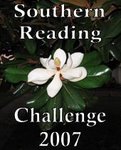I first encountered Daphne du Maurier as a teenager when my grandmother loaned me her worn copy of Rebecca. I remember being completely enthralled, holding my breath with every turn of the page. Had I not had such high expectations for my reading of The House on the Strand due to my fond memory of Rebecca, I may not have been left quite as unsatisfied. This wasn’t a bad novel, just a bit disappointing. In fact, the premise is interesting. I tend to enjoy plots alternating between the twentieth/twenty-first centuries and the Middle Ages or Renaissance—Michael Crichton’s Timeline, Connie Willis’s Doomsday Book, The Intelligencer, The Eight, even the not-so-well-written Da Vinci Code, though the last three are not truly time travel books, but rather mysteries solved with clues from the past.
Plot summary from daphnedumaurier.org:
“Dick Young has been lent a house in Cornwall by his friend Magnus Lane, a professor of bio-physics. He has agreed, while he is there, to act as guinea-pig for a new drug that Magnus has discovered; and the small bottles which hold it are waiting for him in the laboratory at Kilmarth.
With no idea of what the result will be, he takes the prescribed dose - and without warning finds himself back in the fourteenth century, in this same Cornish countryside. During the following days he takes successive 'trips'. Each lasts only a short time, but always he is back in the same surroundings. Invisible, inaudible, he finds that he is a kind of alter ago of Roger Kylmerth, steward to Sir Henry Champernoune, lord of the manor of Tywardreath. He witnesses intrigue, adultery, murder, feeling himself personally involved.
Are the experiences hallucinatory, a subconscious escape from dissatisfaction with his own marital life? Or has he really traveled back in time? This is the question Dick asks himself.
More and more he grudges the hours spent away from these people of long ago, resentful of the time that must be given to his loving though suspicious wife and to his stepsons, intruders into his secret life. With immense skill, the tension is kept on both levels, and, as Dick grows ever more obsessed by his trips into the past, so the reader begins to share his addiction, and to find that past and present become inextricably, perilously mixed - until the final, stunning climax.”
It was the limited character development that truly frustrated me in this novel. Dick Young seems to me a rather shallow individual. We know very little about him, only that he recently ended a career in editing due to displeasure with his job. Dick is a malcontent whose curiosity for the fourteenth century is piqued simply because it is different from his present—perhaps equally complicated, but more logical to him. He seeks refuge from a nagging wife and two stepsons at his friend’s country estate and his brief forays into the past deepen this estrangement. Since Dick is merely a passive observer of the past and has no interaction with the families whose history he is tracing, these passages of the novel have an artificial quality. We witness along with Dick only isolated events in fourteenth-century Kilmarth and have little opportunity to develop sympathies for these characters. Furthermore, Dick’s interactions with the people in his present hardly earn our compassion, either. He conceals his drug-induced time travel from his wife and this growing obsession becomes his only motivation, causing his family relationships to rapidly deteriorate. Du Maurier is quite successful at depicting the single-mindedness of an addict completely dependent on his drug of choice. I only wish that she could have drawn me into her story in the way that her character was drawn to his vice.
If you are looking for a good time travel book, try Connie Willis or Audrey Niffenegger’s excellent book The Time Traveler’s Wife. And for a satisfying Du Maurier read, pick up one of her more celebrated books. There is a reason this one is obscure.
Wednesday, June 6, 2007
The House on the Strand
Posted by Kelly at 4:42 PM
Labels: book reviews, Du Maurier, The House on the Strand, time travel
Subscribe to:
Post Comments (Atom)



0 comments:
Post a Comment